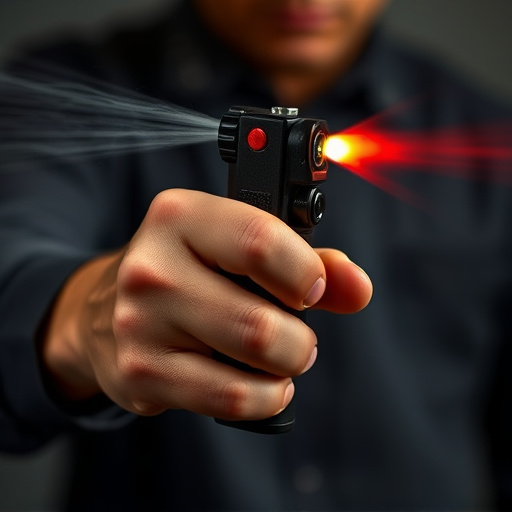Pepper spray exposure requires immediate action, including moving to a well-ventilated area, removing contaminated clothing, washing affected areas with soap and warm water, and seeking medical attention for severe symptoms. Effective treatment involves recognizing symptom severity, using cool compresses, and knowing when to consult professionals. Responsible use of pepper spray includes understanding legal implications, following de-escalation principles, and undergoing training in treating exposure.
Defensive spray has emerged as a powerful tool for civilian protection, offering a non-lethal means of deterring potential threats. This comprehensive guide explores the intricacies of pepper spray—its composition, function, and impact on human physiology. We delve into recognizing symptoms of exposure, emphasizing the critical initial steps in treatment, and highlight legal considerations surrounding its use. By understanding how to treat pepper spray exposure, civilians can gain valuable knowledge for self-defense in today’s diverse and dynamic world.
- Understanding Pepper Spray: What It Is and How It Works
- Recognizing Pepper Spray Exposure: Symptoms and Effects
- Treating Pepper Spray Exposure: Immediate Steps and Medical Considerations
- Legal Aspects and Responsible Use of Defensive Spray for Civilians
Understanding Pepper Spray: What It Is and How It Works
Pepper spray, also known as oleoresin capsicum (OC) spray, is a non-lethal self-defense tool designed to temporarily incapacitate an attacker. It’s a liquid solution containing capsaicin, the active ingredient found in chili peppers, mixed with water and other additives. When sprayed, it irritates the eyes, nose, throat, and skin, causing temporary blindness, coughing, and difficulty breathing. This overwhelming sensation disrupts an assailant’s ability to attack, providing users with valuable time to escape or seek help.
Understanding how pepper spray works is crucial when considering its use for civilian protection. After exposure, How to Treat Pepper Spray Exposure involves several steps. Immediately after coming into contact with the spray, move to a safe location with good ventilation. Remove any contaminated clothing and wash affected areas with soap and warm water. Seek medical attention if severe symptoms persist or occur, such as difficulty breathing, nausea, or prolonged irritation.
Recognizing Pepper Spray Exposure: Symptoms and Effects
Pepper spray exposure can have immediate and lasting effects on individuals, especially in civilian protection scenarios where it’s used for self-defense. Recognizing the symptoms is crucial to understanding how to manage and treat such an incident. Upon exposure, individuals may experience eye irritation, redness, and tearing due to the capsaicin oil present in pepper spray. Respiratory distress is another common symptom, characterized by coughing, difficulty breathing, or a burning sensation in the throat. Skin reactions vary but can include itching, swelling, and rashes at the site of contact.
In terms of How to Treat Pepper Spray Exposure, it’s essential to immediately move to an area with fresh air. Removing contaminated clothing and washing affected areas with soap and water is recommended. For eye irritation, flushing with clean water for at least 15 minutes can help alleviate discomfort. If breathing becomes challenging, using a face mask or moving to an area with cleaner air can assist in recovery. In severe cases, seeking medical attention is crucial, as pepper spray exposure may lead to more significant health issues, especially for individuals with pre-existing conditions.
Treating Pepper Spray Exposure: Immediate Steps and Medical Considerations
In the event of pepper spray exposure, immediate action is crucial. If someone has been exposed to pepper spray, it’s essential to quickly move them to an area with fresh air to prevent further inhalation. Remove any contaminated clothing and wash the affected areas with water as soon as possible. Cool compresses can help alleviate skin irritation.
Medical considerations for pepper spray exposure include seeking professional medical attention, especially if symptoms persist or are severe. Eye irritation may require specialized care, and respiratory distress should be evaluated by a healthcare provider. Understanding how to treat pepper spray exposure involves recognizing the severity of symptoms and knowing when to seek help, ensuring prompt and adequate treatment.
Legal Aspects and Responsible Use of Defensive Spray for Civilians
When considering defensive spray as a civilian protection tool, it’s crucial to understand the legal implications and responsible use guidelines. Laws surrounding pepper spray or oleoresin capsicum (OC) spray vary significantly by jurisdiction, so checking local regulations is essential before purchase and carry. In many places, OC spray is categorized under self-defense laws, allowing individuals to protect themselves from perceived threats. However, misuse or aggressive use of such devices can lead to legal consequences, including charges of assault or unlawful possession.
Responsible use involves understanding the mechanics of the spray, its range, and the de-escalation principle. Users should aim for non-lethal targets like eyes, nose, or mouth, aiming to disable rather than harm. Proper training in how to treat pepper spray exposure is also vital. This includes having a clear understanding of symptoms—which can include coughing, tears, and blurred vision—and access to eye wash stations or other decontamination methods nearby. Responsible citizens should never use such devices lightly, recognizing their potential impact on others and the community at large.
Pepper spray, a powerful tool for civilian self-defense, can be effectively used and managed with proper understanding. By knowing what it is, how it works, and its potential effects, individuals can make informed decisions about its use. In case of exposure, prompt action is crucial. Following the recommended steps to treat pepper spray exposure, as outlined in this article, can help mitigate discomfort and reduce long-term health risks. Additionally, understanding legal considerations ensures responsible usage, promoting safety without crossing legal boundaries.
